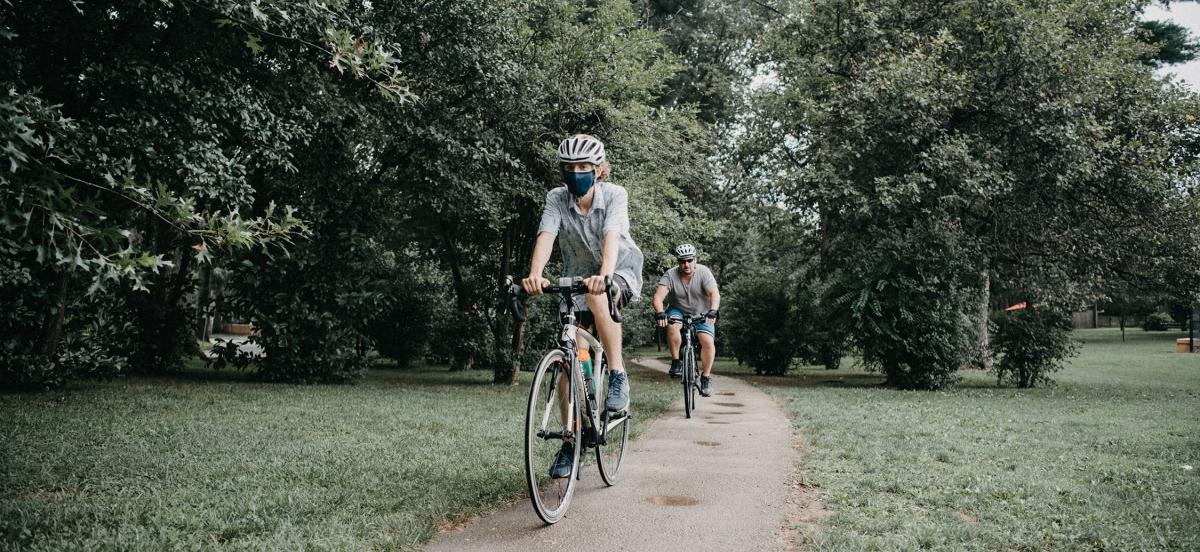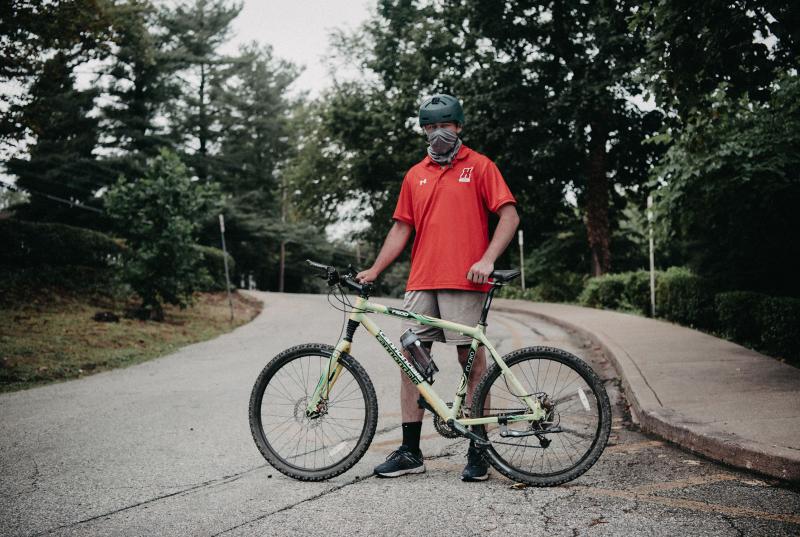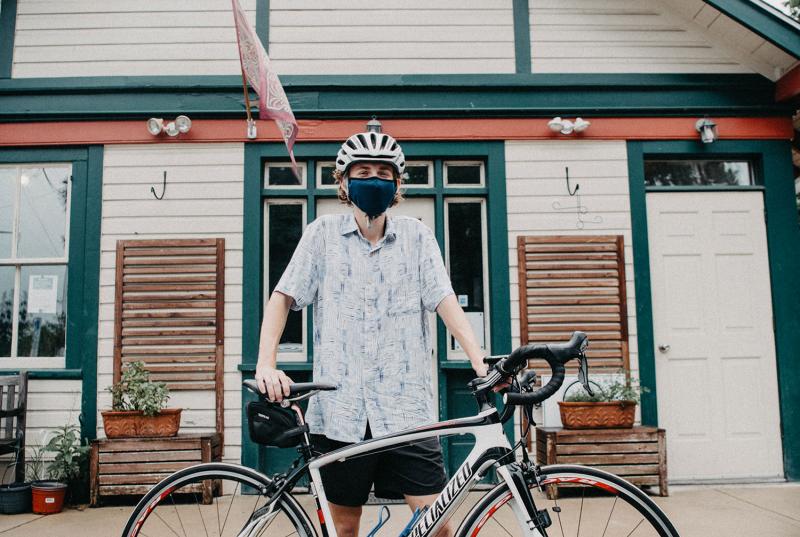Students Help Chart New Main Line Greenway

As the summer drew to a close, Owen Deitcher '20 (pictured here) and Matthew Katz '22 met up with Bryan Shippenberg of Friends of the Cynwyd Heritage Trail and Chris Leswing of the Lower Merion Township Department of Building and Planning to ride nearly 20 miles of the "spine" route of the Main Line Greenway. Photo by Holden Blanco '17.
Details
As part of their Center for Peace and Global Citizenship-sponsored summer internships, Owen Deitcher ’20 and Matthew Katz ’22 worked remotely on the proposed bike route that would offer a more equitable, sustainable, and safe means of transportation through Philly’s western suburbs.
For years, residents of the Main Line, the collection of western Philadelphia suburbs that includes Haverford College, have lamented a lack of safe bikeable streets. There are plenty of well-maintained nearby trails, including the 750-mile regional network known as the Circuit, but they aren’t connected to the social and commercial centers of the local towns, which are linked by busy Lancaster Avenue (Route 30).
Main Line Greenway (MLG), proposed by local bike activists, would connect West Laurel Hill Cemetery in Bala Cynwyd with Stoneleigh Gardens in Villanova, running right through Haverford’s campus. Executive Director of Haverford’s Center for Peace and Global Citizenship (CPGC) Eric Hartman, who commutes to campus on two wheels, is one of those involved in advocating for a more bike-friendly Main Line, and this past summer, two Fords continued the College’s connection to this work by interning with the Main Line Greenway thanks to funding from the Center.
“I saw an advertisement in the CPGC Cafe for a Green Infrastructure and Community Planning Fellowship, and I nearly jumped out of my seat. After attending the informational session, I knew what I wanted to do that summer and the connection formed,” said Owen Deitcher ’20, a growth and structure of cities major and environmental studies and history of art minor. “I feel attached to the Greenway not only through my time as a fellow but through a desire to make the Main Line more-mobility friendly and safe.”

Deitcher was joined by Matthew Katz ’22, a fellow growth and structure of cities major who is also majoring in fine arts and minoring in math, though the two didn’t work together, as COVID-19 necessitated that their internships be conducted virtually. Deitcher either worked from his home in nearby Cheltenham, inputting data, writing descriptions for routes, and detailing possible road improvements, or from the seat of his own bike, riding the proposed route, counting stop signs, determining bike stress level, and taking photos of intersections. Katz worked remotely from New York, editing or creating data in ArcMap, a GIS program, and working on the Greenway’s website and interactive map.
“After spending years learning principles and examples of community planning in the classroom setting, this place-based praxis allowed an inside access into citizen-driven planning,” said Deitcher. “Experiences like these inspire me to, one day, lead community-driven planning initiatives to make communities safer, healthier, and more environmentally conscious.”
“The Main Line is currently perpetuating car culture to an extreme degree,” said Katz. “The Greenway is one of the first steps being taken by the Main Line to change how Main Liners view transportation. The MLG promotes transportation equity because it provides a safe and accessible way to traverse the Main Line without a car. … It links bike paths with existing bus and rail routes, expanding mobility for those historically limited by the linear nature of [SEPTA’s] NHSL or regional rail.”

Despite working apart, the two Fords were able to come together at the end of the summer, along with Bryan Shippenberg of Friends of the Cynwyd Heritage Trail and Chris Leswing of the Lower Merion Township Department of Building and Planning, to ride nearly 20 miles of the “spine” route of the Greenway. It was not only a way to test out the course they had been mapping and building arguments for all summer, but also a way to enjoy the fruits of their labor.
“It felt like I was drifting through a magical world,” said Deitcher of the ride. “The combination of a bright, sunny day and warm weather brought out the richness and beauty of the Main Line scenery. Gardens were blooming, the rich green foliage of the tree canopy enveloped me while riding along certain streets, and the different smells, often masked while driving at higher speeds, engulfed me whilst biking.”
“The Greenway really does check off all the boxes in terms of safety, accessibility, equity, and beauty,” said Katz. “The route is a wonderful cross-section of the Main Line. It crosses so many different areas, each with their own identity and flavor.”
Haverford’s campus, though currently closed to the public due to the pandemic, is an important keystone to the Greenway thanks to its midway location in the bike path network. But both Deitcher and Katz feel the campus is more than just an important central route that could help bikers bypass busy, fast-moving Lancaster Avenue in Haverford and Ardmore; it also represents an important step in the College’s own sustainability plans, which include a bike-sharing program and campus bike repair stations.
“My hope is that the College becomes a trailhead where people can stop, enjoy the Arboretum, and continue on through to the rest of the Greenway,” said Deitcher.
Even though his CPGC-sponsored summer internships are over, Deitcher, who graduated in May, is continuing to work on the project as he begins his Americorp service year and works part-time at Farmer Jawn, a local community-supported agriculture operation. (Katz has paused his work as he takes a gap year from Haverford.)
They hope that as the township weighs budgeting for infrastructure improvements, the MLG can go from “proposed” to a reality, complete with signs marking the paths. But, Deitcher notes, you don’t have to wait for the signs to bike the Greenway yourself. It is free and open and available to bikers--and walkers and runners--who can use the interactive map to guide their way for a safe, quiet, environmentally responsible, and beautiful tour of the township.
"Discovering this route and all the little off-shoots along it means Main Line residents can enjoy the wonderful architectural elements and beautiful gardens populating the western suburbs,” said Deitcher. “It means children can bike safely to school without the parents worrying they will be put in danger. It means an environmentally friendly way to retrieve groceries or grab a bite to eat with friends. Beyond just what I envision the Greenway catering to, the connection of all the universities and colleges of the Main Line through this network could mean collaboration across campuses. For Bi-Co students particularly, the Greenway makes for easy access to routes leading to downtown Philadelphia via the Schuylkill River Trail and MLK Drive. Hopefully this could drum up engagement with partners in the city around mobility issues and increased biking in the Greater Philadelphia region.”
For more on the Main Line Greenway: https://www.mainlinegreenway.bike/



